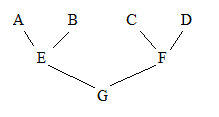I've Ibeen having this question that I can't figure out yet. If you have two unrelated pairs, that is two males and two females all unrelated, how many different gerations can someon produce without inbreeding? I'm pretty sure there's a mathematical formula to figure this out but I haven't yet. Any one have any ideas or answers?
Navigation
Install the app
How to install the app on iOS
Follow along with the video below to see how to install our site as a web app on your home screen.
Note: This feature may not be available in some browsers.
More options
You are using an out of date browser. It may not display this or other websites correctly.
You should upgrade or use an alternative browser.
You should upgrade or use an alternative browser.
How many generations can you produce?
- Thread starter dinamite
- Start date
Big D
New Member
Generations
Here is a chart, that if followed will get you 3 "generations" with no inbreeding. A and C are your original males.
A B C D A
E F G H
EG CE ED FH AF FD GE AG GB HF CH HB
Keeping in mind that only your first generation has one individual of each letter. All later generations not only have more than one individual, they have both sexes. Also, keeping in mind that chameleons aren't monogamous, you could get 12 different parent/grandparent combinations of each sex, for 24 different individual generation-types. At this point, the addition of just one new male would increases your genetic potential exponentially.
Here is a chart, that if followed will get you 3 "generations" with no inbreeding. A and C are your original males.
A B C D A
E F G H
EG CE ED FH AF FD GE AG GB HF CH HB
Keeping in mind that only your first generation has one individual of each letter. All later generations not only have more than one individual, they have both sexes. Also, keeping in mind that chameleons aren't monogamous, you could get 12 different parent/grandparent combinations of each sex, for 24 different individual generation-types. At this point, the addition of just one new male would increases your genetic potential exponentially.
Big D
New Member
Remember, you can breed the unrelated children and grandchildren back to the original stock and not be inbreeding.how about when you breed one pair first and then switch them, such as A&C and B&D
Remember, you can breed the unrelated children and grandchildren back to the original stock and not be inbreeding.
wait, what? how is that not inbreeding? its the same genetic pool still isn't it? or am I misunderstanding the "technical" meaning of inbreeding?
Olimpia
Biologist & Ecologist
To calculate inbreeding, you have to take 2(to the power of #of generations). So in this case to would be 2^3 to get 6 ancestors. If you count the number of ancestors G has in my example it has 6. If G had less than 6 ancestors, inbreeding has occurred.
So, you can breed, for example, (in a scenario where you have A B C D) individuals A to both B and D and get one set of offspring and then C to both B and D and get another set of offspring to get more babies from the same number of individuals. But you could not, then breed their children together because they all have at least a mother in common.
I see lots of combinations but none that will get you more than 3 generations. At some point you will have to add more blood, which wouldn't be difficult.
So, you can breed, for example, (in a scenario where you have A B C D) individuals A to both B and D and get one set of offspring and then C to both B and D and get another set of offspring to get more babies from the same number of individuals. But you could not, then breed their children together because they all have at least a mother in common.
I see lots of combinations but none that will get you more than 3 generations. At some point you will have to add more blood, which wouldn't be difficult.
Solid Snake
Avid Member
wait, what? how is that not inbreeding? its the same genetic pool still isn't it? or am I misunderstanding the "technical" meaning of inbreeding?
I believe he means that you could have offspring from A+B and C+D.
The A+B offspring could be bred with C/D, and the C+D offspring could be bred with A/B.
Provided A+B+C+D are all unrelated.
Big D
New Member
wait, what? how is that not inbreeding? its the same genetic pool still isn't it? or am I misunderstanding the "technical" meaning of inbreeding?
You can only breed back to the original stock, the unrelated f2 and f3 generation. If male A and female B have babies, and male C and female D have babies, the females from AB can mate with C and the males from AB can mate with D and visa versa, the females from CD can mate with A and the males from CD can mate with B. This is assuming that the original stock, A, B, C, and D are all completely unrelated. Oh, and the f3 generation you just created, just to give you one example, a female from AB mates with C, those babies can be called ABC. The ABC males can mate with D and make an f4 generation. Since these babies represent genetics from all four original stock, you would need to bring in new gene lines at this point.
Similar threads
- Replies
- 6
- Views
- 2K
- Replies
- 57
- Views
- 10K





